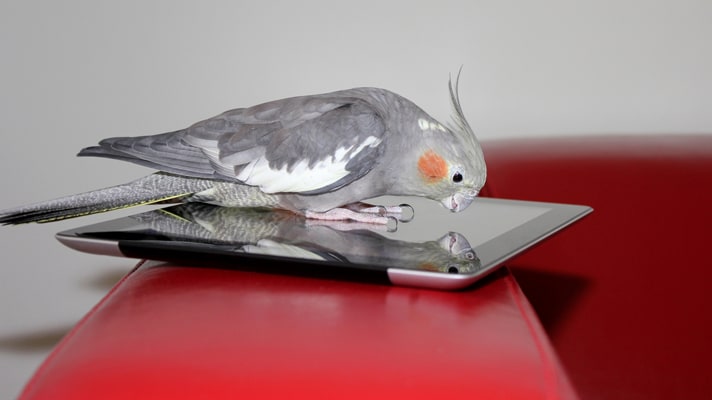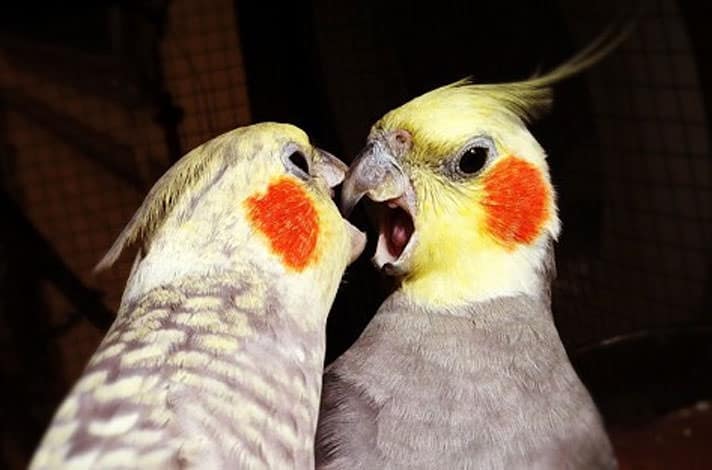1. The Cockatiel “Scristle”
Some people will call this a “scream,?some a “squawk,” and others a “screech,” but whatever you call it, the cockatiel “scristle” (a scream plus whistle) is a frequent cockatiel vocalization. Cockatiels will utter this attention-getting squeal when they are upset, scared, lonely or excited.
I call this vocalization a “scristle” because cockatiels have very melodic, high-pitched voices, so it doesn’t sound like a scream that a macaw or cockatoo makes, but more like train on helium.
Why is your cockatiel is making this sound? That’s easy. As you get to know your bird’s personality, you will come to understand when he’s afraid or just excited. If he’s vocalizing like crazy after you come home from work, clambering around the cage and begging for some head scratches, you’ll know you’re got a happy — yet loud — tiel.
If a cat is stalking your cockatiel, a bunch of helium balloons have floated near his cage or you’re vacuuming, and your bird is making the same excited noises, it’s likely because he’s upset or scared.
2. Whistle
Cockatiels are expert whistlers and will learn to mimic whistles that they hear from their humans, television and the radio. This can be quite cute, because there are a lot of recognizable whistles, from the standard cat-call (or wolf-whistle) to the Andy Griffith television show theme.
There are special whistle teaching CDs and song file downloads that you can play for your bird to teach him or her specific whistles. Male cockatiels are more likely to repeat human vocalizations, but females can be competent whistlers, too.
A whistling cockatiel can be trying to connect with you by picking up human sounds. He also might be bored if he’s sitting alone and whistling to a toy, or excited, based on what’s going on in his surroundings.
3. Chatter/Talking/Singing
Cockatiels pick up a lot of human chatter, words and songs, especially the males. This is their way of blending in — making themselves part of your flock and trying to communicate with you. A talking tiel is usually a happy tiel, but they will also talk when bored.
4. Hiss
Cockatiels hiss when they’re afraid or threatened. A hissing bird is a bird who’s feeling cornered and is likely to bite. Do not put your hand (or anything else) near a hissing cockatiel. Allow the bird to decompress and give him some space.
5. Contact Call
Cockatiels will develop a contact call that they use with each other or with their human friends. A contact call is typical between family members and pairs when one or more of the birds is out of sight. It communicates well-being, kind of like asking, “I’m safe, are you?” Or even, “Hey, come back!” The sound of the vocalization depends on whether the bird is trying to locate an avian pal or a person.
If you’re out of the room and your cockatiel constantly whistles until you come back, that might be his contact call with you. What should you do? Call back! Whistle mimicking your cockatiel if you can (so he comes to understand that you?e calling back), or if your whistling skills aren’t great, say “Hi, [your bird’s name]!” in a high-pitched voice.
Not calling back can create some anxiety for your cockatiel, who will wonder if you’re OK — and if he’s going to be alone forever. Typically, a bird will only contact call if he’s bonded with his human. A stressed and unhappy bird is unlikely to do this, unless he’s desperately calling for a bird or human he misses (in the case of being separated).
Posted by: Chewy Editorial
Featured Image: Via iStock/magbug
Share:










